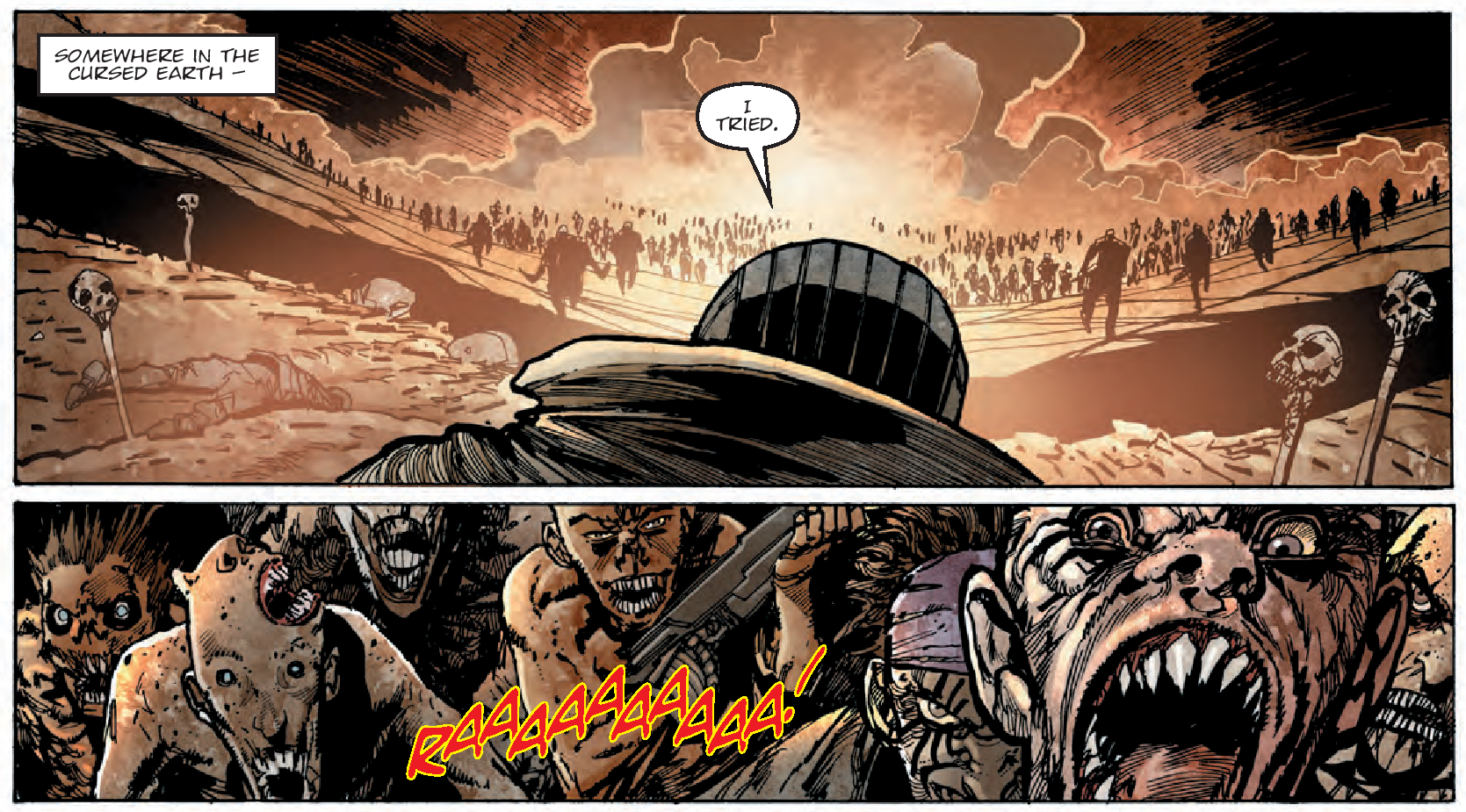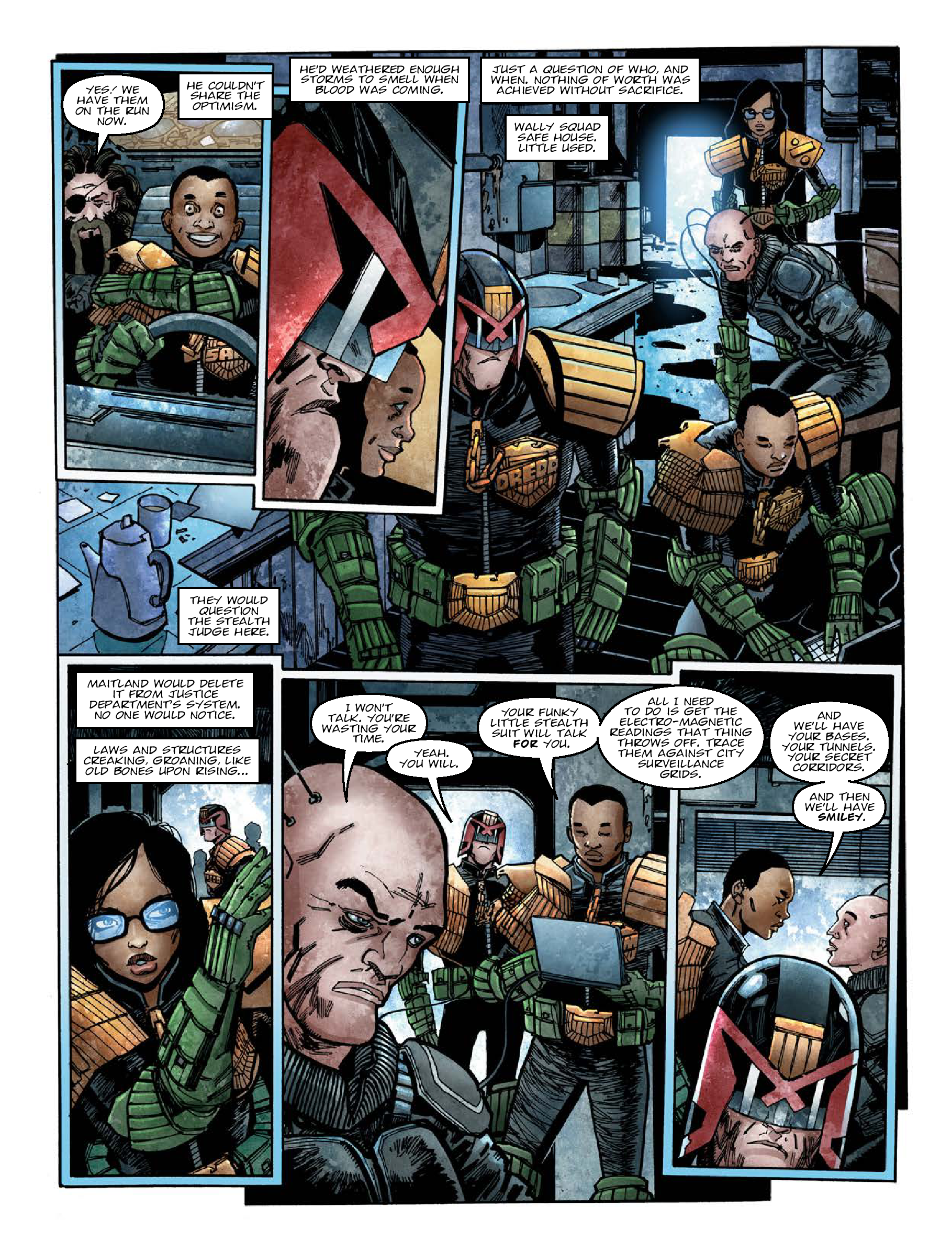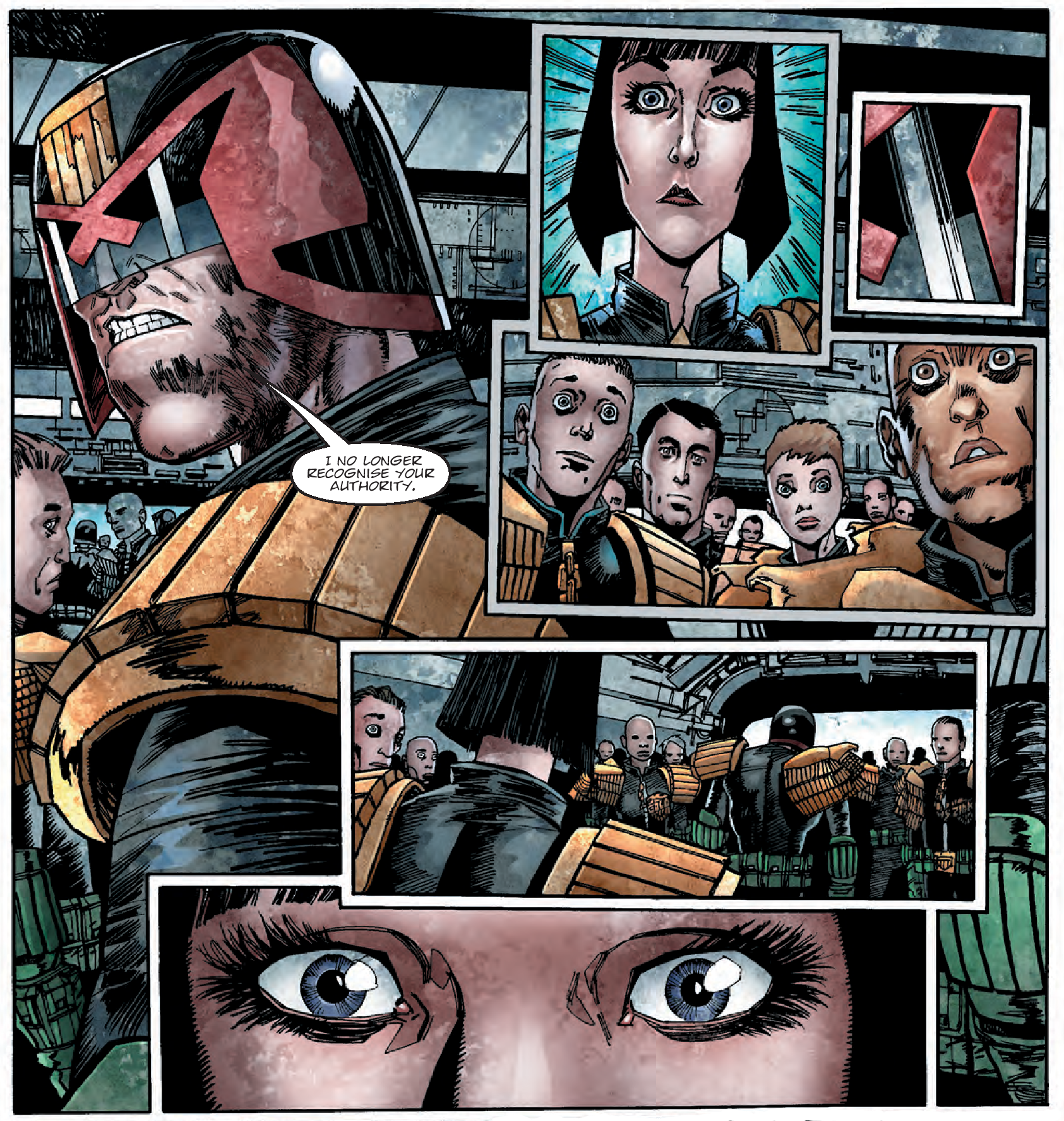THIS INTERVIEW INCLUDES RAMPANT SPOILERS FOR “THE SMALL HOUSE”.
by Jarrod Jones. Grud on a Greenie, what a story.
It’s possible you’ve already felt some of the heat coming off of the latest Judge Dredd tale currently firing through the pages of 2000 AD. It’s “The Small House” from writer Rob Williams and artist Henry Flint, alongside colorist Chris Blythe and letterer Annie Parkhouse, overseen by Tharg himself and delivered with care each and every week from Rebellion Publishing. And it’s been racking up critical praise faster than a Lawmaster on an open stretch of Judge’s Lane.
Whether you’ve been reading Judge Dredd for decades or are just jumping on now, it’s easy to see why. “The Small House”, a 10-part thriller which runs through 2000 AD progs 2100-2109, is structured like the last exhilarating chapters of an already power-packed novel — all killer, zero filler. It marks Williams & Flint’s first longform Judge Dredd story in over four years, and follows a top-secret team of Judges led by Dredd himself who are hellbent on crushing the dastardly Judge Smiley and his sinister machinations once and for all.
Judge Smiley. With his modestly furnished little room and his fine china. He’s an ideal foe for this modern-era Dredd, the type of nemesis who is only too happy to point out the flaws in our hero’s logic, or the contradiction in referring to him as a hero at all. “We’re fascists,” Smiley says to the perpetually grimacing Dredd. With those two words it’s clear Rob Williams is changing the way he approaches the Mega-City monolith. But he’s also challenging the way we perceive this legendary character and how he functions as an authoritarian figure — a daunting prospect, especially these days. It’s a responsibility Williams is taking quite seriously.
“I felt it was time I paid my dues, being honest,” he tells me. “If you’re going to write Dredd for any length of time at some point you have to confront the fact that he’s a fascist head on. I think you need to remind the readers of that too so they don’t see him as something aspirational. Dredd’s world is a cautionary tale. It is anything but a utopia.”
I recently spoke with Rob Williams about his latest Thrill-powered entry in the Dredd saga, and he was kind enough to walk us through some of the more mind-bending moments captured in his latest magnum opus, “The Small House”. Read on, Earthlets, and mind the rampant spoiler warning above.
Required Reading for “The Small House”
DoomRocket: Let’s get folks caught up with your ‘Judge Dredd’ run: Which of Dredd’s many stories are absolutely necessary reading to truly appreciate the scope of “The Small House”?
Rob Williams: I hope, and like to think, we get you up to speed with “The Small House” pretty quick. Basically there’s a team of Stealth Judges with invisible tech undertaking illegal assassinations around the globe in order to prod world events in certain directions. This is being done under the control of a Judge Smiley — a spook who operates as a sort of Senior Judge without portfolio. How much free reign he’s given by The Chief Judge is unknown. But Dredd, and a small group of trusted colleagues, are out to bring down Smiley. Because, as Dredd says, “A creep is a creep.”
These are illegal murders. It’s a crime. So Dredd’s going to try and bring Smiley down, even if it could mean the collapse of the Judge system.
Some prior — very good stories — you could enjoy for context are “The Apocalypse War”, “Trifecta”, “America”, “Titan” and “Enceladus” and my “Low Life Dirty Frank” stories going back to “Low Life: Creation”. But, yeah, I think you can enjoy “The Small House” if you’re new to Dredd.
PROG 2100, “The Small House, Part One”

Art by Henry Flint, Chris Blythe and Annie Parkhouse/2000 AD/Rebellion
This picks up immediately after the events of “Act of Grud”, which focused on both Judge Sam and Dredd’s secret team of Judges as they searched for the elusive Enceladus energy. Can you bring us up to speed on what this is and how this aides the Stealth Judges?
RW: In ‘Enceladus’ Judge Sam found there was an amazing new energy source beneath the surface of the Titan moon. The Judges brought it home, Smiley took it and used it to upgrade his stealth Judges. Now they can not only be invisible, they can actually walk through walls. As can he.
Judge Sam has developed goggles and sensor arrays to allow him to spot and follow the Stealth Judges.

Art by Henry Flint, Chris Blythe and Annie Parkhouse/2000 AD/Rebellion
When was the last time we saw Dirty Frank, and how did he end up in this moment?
RW: Dirty Frank is an undercover ‘Wally Squad’ Judge who we know has a historical connection with Smiley — see “Trifecta” — but we don’t know what. Frank was last seen in “Act of Grud” acting as one of Dredd’s trusted team, trying to track down and bring down the Stealth Judges. When “The Small House” starts, Dredd has sent Frank abroad to try and prevent one of Smiley’s assassinations.
Where is Dredd at this point in your story psychologically? How has he been coping with the strain of running a covert team under the nose of Judge Hershey, and how does he reconcile his shady actions with his suspicion that the Justice Department might be subservient to Judge Smiley?
RW: Dredd’s suspicions have been confirmed — he knows Smiley has been assassinating pro-Democracy politicians. Dredd’s a simple animal in many ways. A crime is a crime. So Smiley needs bringing down. Whatever the consequences. But there’s always several levels of subtext with Dredd, even if he’s not entirely fully aware of his motives, I think. That’s what I find interesting about writing him. He’s angry. He’s going to rip this down no matter the cost. And he knows there will be a cost — either to the system he’s served so long, or to his “friends.”
PROG 2101, “The Small House, Part 2”

Art by Henry Flint, Chris Blythe and Annie Parkhouse/2000 AD/Rebellion
When Smiley begins his conversation with Dredd, he refers to Joe as “The Titan”. Is this a reference to Aimee Nixon, and her past attempt to strip Dredd of his righteousness (or self-righteousness)? Is Smiley purposefully shaking the ground underneath Dredd’s feet?
RW: Yeah, Smiley knows exactly what he’s saying here. But there’s more to this that only gets revealed in the final act. My previous story about Dredd was called “Titan” not just because of it being the Saturn moon where the Justice Department prison is set, but because Dredd is the titan of this comic, this world. Nixon wanted to show Dredd he was just a murderer who uses the law as an excuse to justify his rage. Smiley sees Dredd as something different. He appreciates how useful Dredd is as a thuggish bogeyman to scare the citizens in behaviour, and what an impressive weapon he is. But you’ll have to read til the end to find what Smiley truly thinks of Dredd.

Art by Henry Flint, Chris Blythe and Annie Parkhouse/2000 AD/Rebellion
Let’s talk about Smiley’s line (“We’re fascists”) and how acknowledging the authoritarian rule of the Judges can radically shift the paradigm of Judge Dredd. How did you know you wanted to address this concept explicitly in “The Small House”?
RW: I felt it was time I paid my dues, being honest. If you’re going to write Dredd for any length of time at some point you have to confront the fact that he’s a fascist head on. I think you need to remind the readers of that too so they don’t see him as something aspirational. Dredd’s world is a cautionary tale. It is anything but a utopia.
Fascism is inherent in the character and the world’s concept. The Judges are not the good guys — except Dredd sometimes is… That’s why the next issue after the ‘We’re fascists’ line I had the scene with the escaped dune shark eating citizens. If you’re one of those citizens being attacked you want Dredd to show up, to protect you. This is a complex character for those reasons. And our world being where it is right now, where fascism is rising in Europe and in America. Where there are dangerous right-wing groups gaining power. I felt that I had to write a Dredd story that acknowledges the dangers.
Smiley has a line about death already having claimed this world but it’s only his actions that stops the city falling into the abyss. Maybe he has a point. The best villains often do. But are you willing to sacrifice everything good and noble to achieve that survival?
There’s no easy answers to these questions. So, in a world of chaos, all you can hold onto is Dredd with his viewpoint ‘murder is a crime, and so you are a creep who needs arresting.’ Dredd’s a very Peckinpah-like character. Simplistic. A line must be drawn… somewhere.
At least that’s what he tells himself. I suspect his true motives may be something other… 40 levels down. It’s complicated.
PROG 2102, “The Small House, Part 3”

Art by Henry Flint, Chris Blythe and Annie Parkhouse/2000 AD/Rebellion
We witness what appears to be the final moments of SJS Judge Alex Gerhart during his Long Walk. Is it safe to ask what becomes of Gerhart? Does Dredd know about this alarming development?
RW: Going to take the fifth on this one. Gerhart also plays a part in the Judge Pin storyline I’ve been doing with Chris Weston. So, wait and see.
PROG 2103 & 2104 “The Small House, Part 4 & 5”
What is the significance of this strand of hair Hershey holds? And why does her predecessor’s name — McGruder — come up?
RW: Hershey’s fate and longevity are a major theme of “The Small House”. Is she complicit in what Smiley’s been doing? McGruder was a longstanding Chief Judge who, in a typically askew bit of writing by John Wagner, grew chin hairs, even though she was female. I liked this scene with Hershey. She — previously an action hero with Dredd in stories like “The Judge Child” — is bored stupid listening to some city planning stuff, and finds a single hair growing from her chin. She thinks of McGruder, and, yeah, just a human moment. Maybe Hershey’s been there too long?

Art by Henry Flint, Chris Blythe and Annie Parkhouse/2000 AD/Rebellion
In these installments, Dredd, Giant, Maitland and Sam interrogate a Stealth Judge and later they bust a Stealth Judge base. Both of these operations occurred while they manipulated M-C1’s surveillance grids. If you would, describe to us how far Dredd’s willing to bend the law to bust Smiley and his Stealth Judges. Is Maitland’s protests in Prog 2105 your way of articulating that Dredd is going too far?
RW: Dredd doesn’t know who to trust. After “Trifecta” Hershey allowed Smiley to keep operating. So, maybe Hershey knows? Maybe she authorised his assassinations? If that’s true, then the whole of Justice Department may be on the opposite side to Dredd and his team.
So, in going after Smiley in this way, Dredd knows full well that he could be bringing the entire system crashing down here. And he’s willing to do it, because crimes are being committed and he is a Judge. There’s an arrogance in this. He believes his judgement is absolute.
The Kazan clone has been cooperating with Dredd by giving up info on Smiley piecemeal, and has apparently been repaid in kind by the tea-sipping Judge. What is the significance of his chessboard, the one Dredd shot to pieces back in “Trifecta”?
RW: The chessboard was an easy metaphor for Dredd and the Kazan clone’s meeting in” Trifecta”, which Al Ewing, who wrote that scene, then undercut by having Dredd shoot the chessboard. A very Dredd blunt tactical move. Smiley tells Dredd early on here that he is “not a tactician.” But I will say that it’s unlikely Kazan has kept the chessboard pieces for sentimental reasons. The Kazan clone is a tactician.
PROG 2105, “The Small House, Part 6”

Art by Henry Flint, Chris Blythe and Annie Parkhouse/2000 AD/Rebellion
Judge Sam survived Enceladus only to meet his end in “The Small House”. He muses (via captions) that the universe prolonged his “narrative” because he was needed for something big down the line. Did you know that you were going to be killing off Sam in “TSH”? How do you feel about offing your own characters?
RW: I knew Sam was going to get it here, yes. I felt bad about it because I liked the character very much. A genuinely optimistic, kind, hopeful man. Which is precisely why he had to die. If I did my job right you’ll feel terrible about Sam going too. [Editor’s note: Yep. You did.]
PROG 2106, “The Small House, Part 7”

Art by Henry Flint, Chris Blythe and Annie Parkhouse/2000 AD/Rebellion
The sequence where Dirty Frank comes undone, courtesy of Smiley, the page is laid out in a nine-panel grid. Is this an homage to the works of Alan Moore, upon whom Dirty Frank is visually based? Or am I reading too much into this?
RW: Ha. No, but I wish we’d thought of that. I just thought the 9-panel grid there was a good way of suggesting order — which contrasts with Frank slipping into insanity via some of the visuals. the 3 ordered ducks on Smiley’s wall becoming hellish nightmare creatures, etc. Order’s a big theme in “The Small House”.
It appears that Smiley’s hypnotic hold has kept the uglier facets of Frank’s past at bay since “Trifecta”.
RW: There’s a line in “Trifecta” where Smiley tells Frank, who he’s rescued from the snow, “Wally Squad, I think, Judge Frank. I could use someone in Wally Squad.” Smiley places him there. Frank’s mental instability came about partly because of what happened in the snow, and partly because on some level Frank knew that Smiley was in his head, somewhere. Able to snap his fingers at any point.

Art by Henry Flint, Chris Blythe and Annie Parkhouse/2000 AD/Rebellion
Here it is. The biggest moment in a story rife with big moments. Dredd declares in full view of the Justice Department that he no longer recognizes the authority of Chief Justice Hershey and the Department itself. How did you openly hide from the reader that Smiley was moving Dredd into direct opposition of the very structures he’d sworn to uphold?
RW: I think it’s been there throughout the story. Dredd’s actions are secret and not authorised by Hershey and Justice Department. I think what’s interesting about this moment is Dredd saying this line to Hershey is a very human, flawed moment. He is not a robot. He’s just found Judge Sam killed, he suspects at that point that Frank did it (he doesn’t know for sure). Maitland has just — rightly — called him out for allowing Sam to die. Dredd knew that there’d be a cost to all this. So, his anger is biblical when Hershey confronts him, and he blows that anger at Hershey in front of a room full of Senior Judges.
It is not a tactical move. Dredd operates via his gut.
Hershey’s non-reaction is because she knows, deep down, that Dredd’s right. That goes back to the McGruder hair scene. Hershey knows her time is up. When Dredd says this to her, she can’t find it within herself to fight him on the subject.
A big, very human, flawed moment, that will have big repercussions.
PROG 2107, “The Small House, Part 8”

Art by Henry Flint, Chris Blythe and Annie Parkhouse/2000 AD/Rebellion
It’s here where we finally discover the relevance of ”the Snow”, what the experience did to Dirty Frank, and how Smiley is involved. We also discover where the name “Dirty” came from. Was this harrowing backstory always a part of Frank in your mind? Is it possible this wild plot point will come up again in future Dredd stories?
RW: It was always there. Some of the details weren’t. I knew Frank was on an unofficial Justice Department hit squad mission. That he was part of something terrible, wouldn’t go through with it, and effectively died in the snow. I knew it was something to do with the Sovs and that one day I’d get around to revealing it all. Smiley came into existence later with “Trifecta”. So, you have the major blocks in your head and fill in the specifics much later. It’s an evolution.
So where will Dredd go after “The Small House”, do you think?
RW: No idea.
“The Small House” comes to its Thrill-powered conclusion in ‘2000 AD’ progs 2108 & 2109, which you can order here.
















